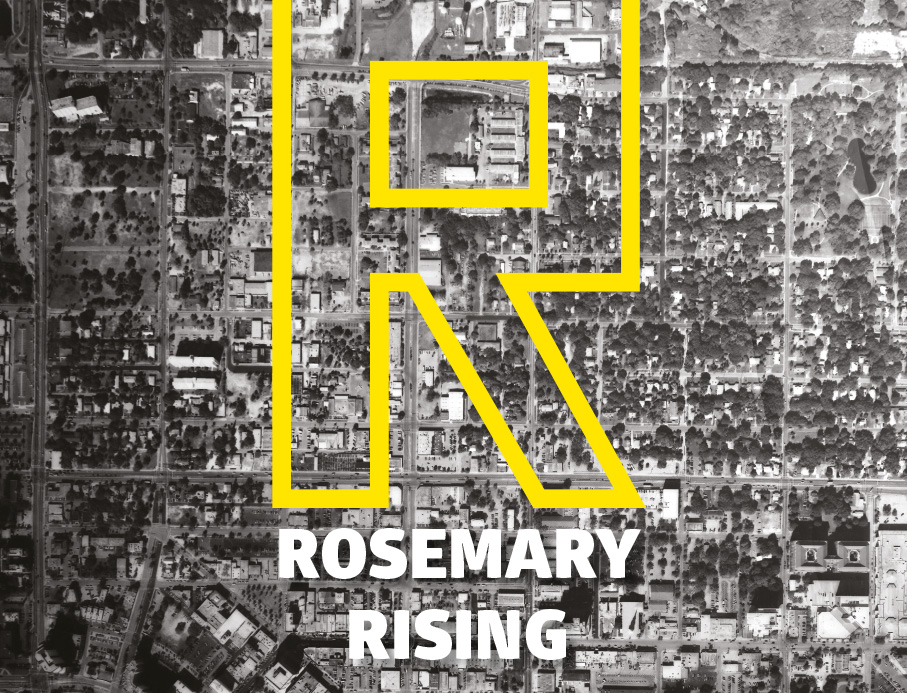Amid the French cafes and architectural firms that line the streets and floating in the air around apartments and condominium units standing four stories into the sky, the atmosphere brims with the Rosemary District’s defining characteristic—potential. It’s a hope left unrealized for decades but one longtime residents and true believers could always see, what early settlers to modern investors found and clung to through years of recession, oppression and disappointment.
Today, a stroll through Rosemary means a walk past diners noshing on sandwiches and sipping warm cups of coffee at The Rosemary on Orange through the day, or past hipsters sharing beers at the Mandeville Beer Garden, or architects at Halflants + Pichette plotting built wonders now peppering these corners. Yet not so long ago, Central Avenue would have the odd look of newly renovated storefronts abandoned by immediate past tenants, sitting across the street from beloved but struggling restaurants. Those days seem gone now, as businesses clamor for space and residents move in to new apartments at Cityside or place reserves on condo units at the Courtyard at Citrus Square. “The progress is a magnet to the area,” boasts City Commissioner Willie Shaw. “It’s good to see that growth.”
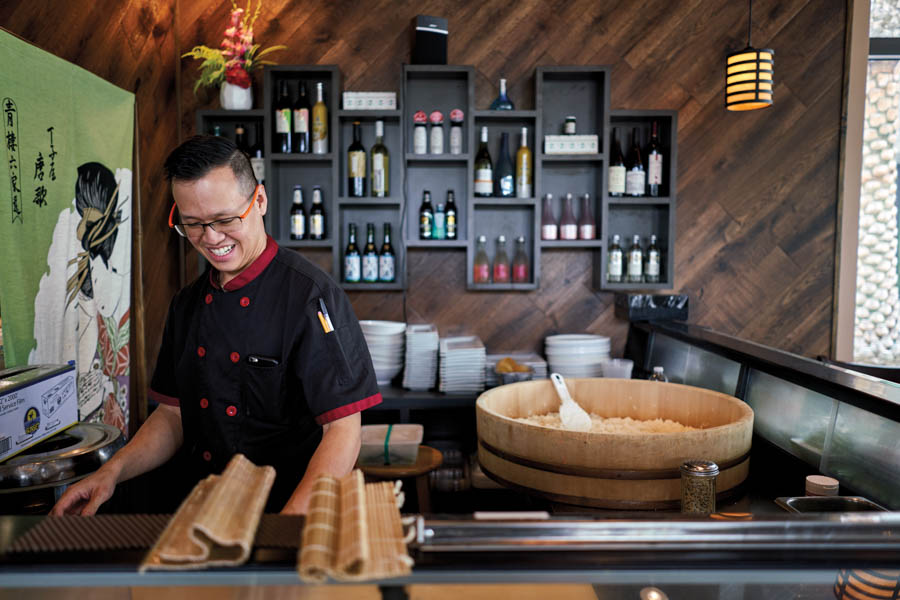
A lull at Spice Station, photo by Wyatt Kostygan.
Overtown to Rosemary
A Divided Past & Early Efforts
In truth, people lived in Rosemary for as long as there’s been a Sarasota. The first settlers came to the area in 1885, according to Sarasota historian Jeff LaHurd. That’s when Lewis Colson came in with a team of surveyors from the Florida Mortgage and Investment Company and decided to stay. One of the first black settlers to come into the area, he dubbed the area Overtown, named because it was north of the white settlement in modern Downtown Sarasota. Colson in 1897 opened the Bethlehem Baptist Church and served as its minister through 1899.
As a minority community formed there, the Overtown community grew, but it took on the racially pejorative nickname of Black Bottom for many years. The Rosemary Cemetery opened there, but served as burial ground primarily for Sarasota whites; Colson and his wife remain the only black people ever to be buried there. The area’s population continued to grow, but in a segregated era, as economic vitality stayed downtown. LaHurd says as the town started to spread out in the 1920s, as Overtown and Sarasota connected to become part of the same community, albeit a segregated one. As society slowly integrated, the make-up of Overtown became more mixed but most residents remained poor. And several eras of near-dashed hopes would pass before the region would be reborn as the Rosemary, and more time yet before a new city code finally stimulated economic growth.
By the 1950s and ‘60s, LaHurd says, Overtown started to become more established, but the growing black population of the city started to be pushed westward, to what’s still known as Newtown. Then as shopping malls and strip centers came into vogue in the 1970s and 1980s, traditional economic centers like downtowns and communities filled with locally owned stores—like Overtown—felt the impact. Blight started to overtake the north Sarasota neighborhood and buildings disappeared with nothing coming in to replace then.
The city took notice of spreading blight in 1994 and put together the Rosemary District Plan, the first time an official document used the cemetery’s name to rebrand the whole neighborhood. But little happened there, at least not before City of Sarasota officials hired planner Andres Duany to create a master plan for the area. Duany saw tremendous potential in the Rosemary—if it could be connected in a pedestrian-safe way to Downtown. He rolled the meat of the 1994 plan drafted by city Planning Director Jane Robinson into his own 2020 Downtown Master Plan. “Use the existing positive characteristics and physical infrastructure as the basis for improving the civic realm in the neighborhood,” Duany wrote.
Sarasota City Commissioners adopted the Duany plan in 2001, though thanks to court challenges it didn’t officially go into effect until years later. The Rosemary, a periphery neighborhood in the plan, didn’t see the immediate jolt felt in the heart of downtown, but the plan spurred mixed-use developments like the award-winning Citrus Square, a still thriving development that opened on Orange Avenue in 2011. And believers in the coming revitalization set up shop.
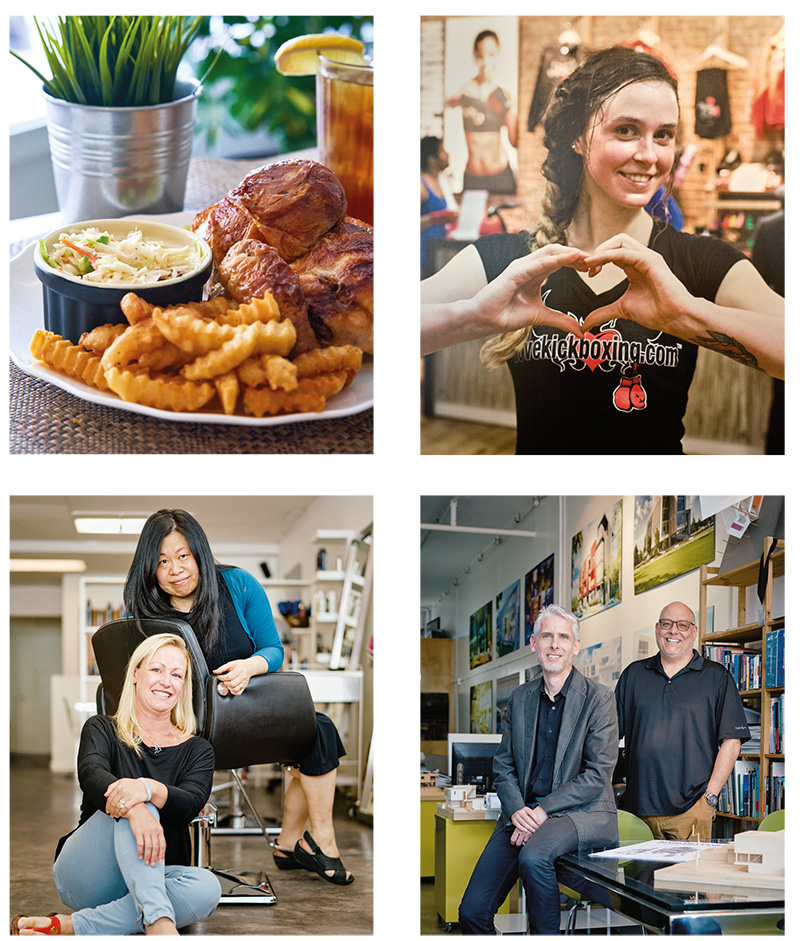
Below, clockwise from top left: Smoked chicken plate from Uptown Eatery, iLoveKickboxing in the heart of the Rosemary, Architects Michael Halflants and John Pichette in their Rosemary offices and Miho
Miho Hosaka, co-owner of Dasaka Salon, saw the potential of commercial activity on Central, so she and business partner Darcy Persibul opened their doors around 12 years ago. Already established stylists in the city, they brought a solid business clientele with them. “We were okay on the business side,” Hosaka says, “but safety-wise, it felt a little sketchy and a little tricky.” Most of the pedestrian activity in the day, she recalls, was transients walking between the Salvation Army on 10th Street and the restaurant district in Downtown Sarasota. “But we knew we had to make it here,” she says. Others came in, too. But not all would stay. Business incubators like the HuB took over largely empty warehouses. And James Beard Award-winning chef Derek Barnes opened Derek’s Culinary Casual in the District. But then the housing bubble burst in the state of Florida in 2007, and as the Great Recession struck the nation in 2008, redevelopment stalled. The HuB moved to Downtown Sarasota and Barnes closed his restaurant down to open a new establishment in Bradenton; The HuB would relocate one more time but still remains active in Sarasota while Barnes has closed his new restaurant as well.
The fresh Rosemary seemed to wither on the vine. “For a long time, the Rosemary District was really a vacant piece of land with huge buildings placed here and there,” says Michael Halflants, a principal at Halflants + Pichette. Promised construction projects remained dormant for years, recalls Francine DiFilippo, chairman of the Downtown Sarasota Alliance. “Properties were torn down, and the city owned a lot of non-revenue-generating real estate, which is never good for a government entity.”

Michael Bush of Home Resource, photo by Wyatt Kostygan.
Longtime tenants like Home Resource owner Michael Bush tried to brand the region as the Sarasota Design District, thanks to a proliferation of architecture and home interior companies. “The community will benefit from the close association of these professionals and their drive to push the Sarasota Design District to the level of prominence of other design districts in the world,” Bush said. But ultimately, it would be residential construction that finally turned things around for the Rosemary. That seemed to elude the neighborhood—until a fresh look at the code in 2014.
Rezoning to Revitalize
Enter the Overlay
The problem developers faced post-recession in re-sparking interest in the Rosemary largely had to do with real estate values and some largely unworkable math. The district seemed the right spot to market to young professionals—the kind who can’t afford to live in high-rise condominiums in the core of downtown, but who want to live near their offices and those of colleagues.
But precisely because of proximity to downtown, real estate values were so high it would be difficult to even get financing for a residential project in Rosemary unless a lot of separate units could be sold, and city zoning there only allowed development of housing projects with 25 units per acre or less. That means developers would have to build larger units and sell them to fewer people, pricing out working class people while wealthy retirees favored pricier property on the islands or in the city core.
“One of the big issues with the downtown code, for all of the city really, is the densities are too low,” Halflants says. “Even in areas where you can do a 10-story building but you can only do 50 units an acre, you are forced to build very large units. And so you have sales prices that start at $2 million, $3 million, $5 million.” Halflants, whose offices have been in Rosemary now for 12 years, says from experience it’s tough to sell multi-million-dollar condos from a sales office while homeless people walk past the window in front.
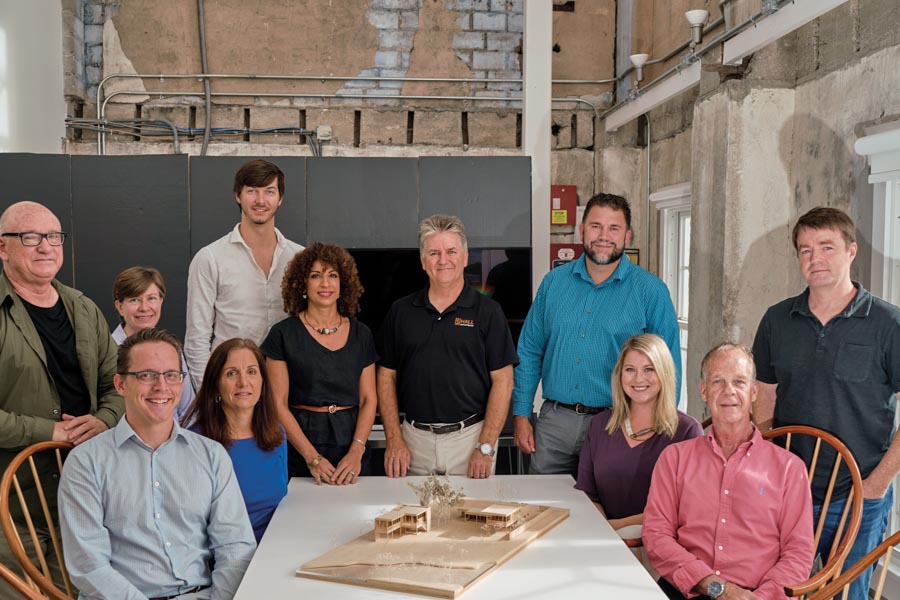
Hall Architects, photo by Wyatt Kostygan.
Bruce Weiner, founder of Rosalyne Holdings, says the area needed working people living there—and a decent number of them. So luxury condos wouldn’t suit the bill. “The more people we can get in the Rosemary District, the more people will want to live there and the more likely it is shops and restaurants and bars and convenience stores will continue to open there,” he says.
That’s when land owners started talking with city officials about the creation of a new zoning overlay district, one that encouraged dense residential construction, at least a limited amount of it. City officials looked at the amount of land in the district that would never see residential development, whether because it held public facilities like parks or purely commercial uses, and they started to calculate how many residential units could theoretically be built in the Rosemary if all the land could have its highest-maximum use. Then they looked at how those units might be concentrated on the properties available for construction. Steve Cover, planning director for the City of Sarasota, says city leaders wanted to revitalize the region when they developed new rules within the Rosemary Residential Overlay District. Basically, the city defined the Rosemary as the area bound by Fruitville Road, Tamiami Trial, 10th Street and Orange Avenue—an area spanning 71 acres—and figured 1,775 residential units should be available to developers before the overlay expired. Individual projects in the neighborhood could be built with as many as 75 units per acre. “What you’re seeing now is one of the most exciting districts within the city,” Cover says.
Weiner moved ahead with Cityside, a four-story apartment complex opened in 2016 at Boulevard of the Arts and Florida Avenue that brought 228 units online in its first phase, some of those studios as small as 572 square feet. “The density boost is critical because it really wasn’t feasible for us or others to develop an economically sustainable project with only 25 units an acre,” Weiner said at the time.
Developer Mark Kaufman set up partnership with the Sarasota Opera House to build artist residences in the Rosemary. And more luxury apartments like Elan Rosemary soon opened as well, though catering to high-end renters.
Halflants, the architect for Risdon on 5th, says the code made it possible for developments to cater to all income levels. When the Risdon started showing units for sale, Halflants decided based on the new density rules to design a couple 700-square-foot units to gauge interest and found working professionals clamoring to have a humble condo unit within walking distance of the nightlife downtown. The first units of 22 constructed at Risdon to get sold, beside the luxury penthouse, were the eight one-bedroom units in the project.
And then there’s been the arrival of cultural institutions and restaurants. The Westcoast Black Theatre Troupe left downtown and relocated to the edge of Rosemary. Alfstad& Contemporary, from the minds behind the IceHouse, became one of the hotter gallery spaces for large exhibits. The Rosemary opened on ground level at Citrus Square. And The Players Studio a year ago opened the Arnold Simonsen Players Studio, an education-focused performing arts facility. Just down the street and around the same time, Sarasota Contemporary Dance found a new home in its first dedicated movement center.
Shaw says the timing ultimately proved incredible in terms of initiating policy to spark development at precisely the moment when investors wanted to make a move. “We are in an economic book period, and that has drawn quite a bit of interest in Sarasota as a whole,” says the former Sarasota mayor. “The Rosemary has marketed itself very well.” Now, community leaders are starting to ask what comes next in the Rosemary, and to figure how to continue the path of success.
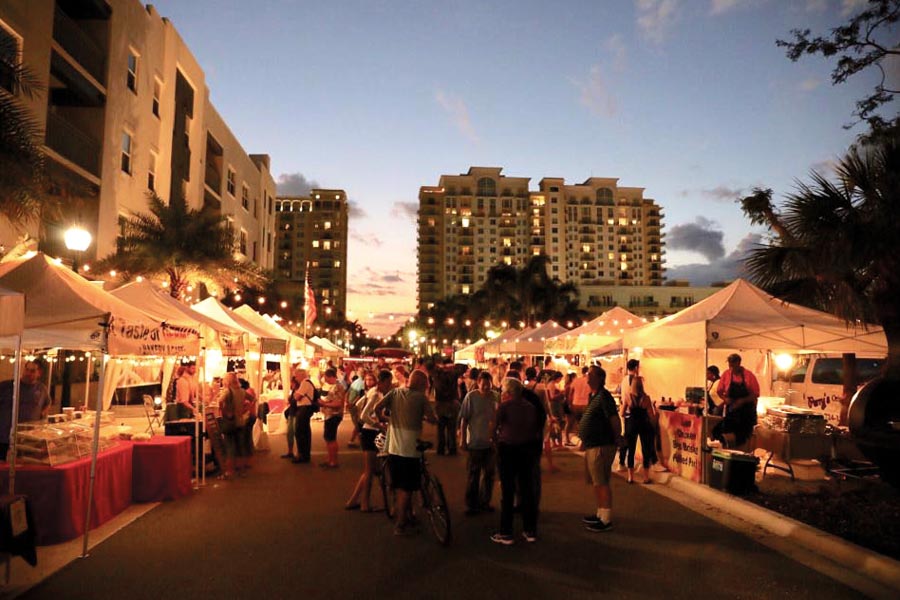
Side Effects
Growth and Gentrification
At the same time city leaders celebrate the boost in the economy brought on by the Rosemary district, there’s also been a major change. While Newtown and Overtown at one point felt like one large neighborhood, there’s now a complete distinction, and nearby public housing projects at Janie’s Garden feel a world away from the thriving boom on Central Avenue. LaHurd says the gentrification of the Rosemary District since the end of the recession has been historic. Shaw would like to see existing residents to still have a place in the community as the district moves forward. “All of Sarasota is being gentrified; let’s be clear on that understanding,” Shaw says. But he doesn’t want Rosemary to completely lose its identity or its history.
Developers say they want to be mindful of the existing neighborhoods. Josh Weiner, Bruce Weiner’s son and part of Cityside’s development team, says particular effort has been put in place around that development to create community areas. The streets on May Lane have 20 feet of sidewalk space. “I think a lot of developers may take the back 10 of those feet and make that rentable square footage,” he says, “but our goal is to push that outside area on May Lane and give the neighborhood an opportunity to activate.” He worked with the Sarasota Farmers Market this summer to turn May Lane into a venue for the market on Thursdays. “It was generally successful,” says Phil Pagano, market manager. With construction going on right now, Pagano says the market has gone on hiatus, but he’d like to start it up again. But there will be a lot of changes happening in the area in the meantime. Citrus Square developer Mark Pierce announced an adjacent condominium project, Courtyard at Citrus Square, which will bring online more ground level retail as well.
And Josh Weiner says the second phase of CitySide, called the Bayside Club, will bring more luxury to that project. The new expansion will have a rooftop garden overlooking Sarasota Bay, and higher-end amenities for tenants. “It will be a pretty special development,” he says. While the project will be marketed as a separate brand property, developers plan synergy in terms of the open community spaces. But while the development will ratchet up the luxury feel to the Rosemary, Josh Weiner says Cityside will continue serving a population with a more moderate income. About a fifth of Cityside’s units fall under the category of “attainable housing,” priced to serve renters who make less than the annual median income for the area.
What Now?
DiFilippo says that the Rosemary today has moved into a state of maturity. “The early people to come in along Central Avenue have come and gone several times, but that’s the nature of redevelopment,” she says. It’s not just zoning. Commercial restaurants need to develop loyal followings, the way Lolita Tartine and Station 400 have done over years. Even with popular foodie-focused businesses like the Spice Station, Main Street still has about five times as many successful restaurants as the main commercial corridor in Rosemary, by DiFilippo’s count; improving that will help the area flourish further.
She’s most concerned with whether housing prices will once again stifle the ability of professionals and residents to stay in the community. But hopefully the free market will settle that. “I’m not privy to what every landlord is charging for rent, but one would assume that to get people into the area as tenants, they will be doing some wheeling and dealing,” she says. Hosaka says the newest concern for her business is that new construction and more residents mean fewer places where her regular customers can park. For the longtime businesses who weathered the down years, it’s frustrating to see success inconvenience their most loyal patrons. She’d like the city to prioritize construction of a parking garage in the Rosemary.
As for zoning plans, development has quickly neared that cap set up by the zoning overlay four years ago. If one 230-unit development gets its permit, the district expires, Cover says. At that point, zoning on all land drops down to allow 25 units per acre.
So city planners will once again discuss the future of the Rosemary. How can the region be increasingly viable for commercial activity? Does it even need residential development incentives anymore? These questions will likely land in front of Sarasota City Commissioners as various proposals move through city hall. “We are testing out concepts and ideas that we think will work,” Cover says.
Among proposals, especially considering the strong cultural assets of the district, could be a new way to direct public art projects to arise in the area. Sarasota has a law on the books requiring major developments to include public art, as many downtown condominium projects have done with sculptures immediately outside their doors, or by contributing to a fund to finance purchases of work by the city. Cover says the public art fund can be used for work anywhere in the city limits, but he’d like to earmark funding from the mid-sized developments rising in Rosemary for the neighborhood.
Cover says the city will also look at increasing sidewalk size throughout the district, especially considering recent concerns raised in Sarasota about whether a development boom has led to buildings too close to pedestrian-filled streets. Planners would also like to see more mixed-use developments, perhaps signaling an end to pure residential density incentives as efforts turn instead toward increasing office space and storefronts.
Halflants says the streets feel much safer now, partly because more people can be seen throughout the day walking the streets, but also because new developments follow an eyes-on-the-streets principal. “More people are living here and have terraces and windows looking toward the district,” he says. “It’s a safer environment and it feels safer, with more people on the sidewalks.” He’d like more trees providing natural shade—and some city guidelines to make sure the vegetation planted looks uniform and connects the community together. DiFilippo, whose organization also represents residents, fears the district will soon price out residents, both existing ones and the professionals the city worked so hard to make room for in Rosemary, if development continues to become increasingly upscale. The city needs to make sure affordable and attainable housing remain a priority in north Sarasota, she says.
Another priority for the city will be boosting the connectivity with the rest of downtown. DiFilippo says the greatest challenge for the region may be making sure people can safely walk between Downtown Sarasota and the Rosemary District. “The biggest problem is connecting it psychologically across Fruitville Road,” she says. Right now, crossing that major traffic corridor means a frightening walk across a lengthy street.
Shaw believes it’s just as important to consider the connection between the Rosemary and The Bay cultural district now being planned on publicly owned land by the Van Wezel Performing Arts Hall. “It’s the area of residence that is closest to the Bayfront, and that is going to drive entrepreneurship in the area,” he says.
As parking problems follow the sudden success in Rosemary, officials have considered building a public parking structure, something that’s proved successful downtown.
Regardless of what happens next, officials say the successes at Rosemary so far have been something nobody wants to knock off track. In fact, Cover sees the density incentives and community efforts in the North Sarasota neighborhood as something to be tried in other parts of Sarasota in need of redevelopment. “What we want to do always,” Cover says, “is to enhance the public realm.”





